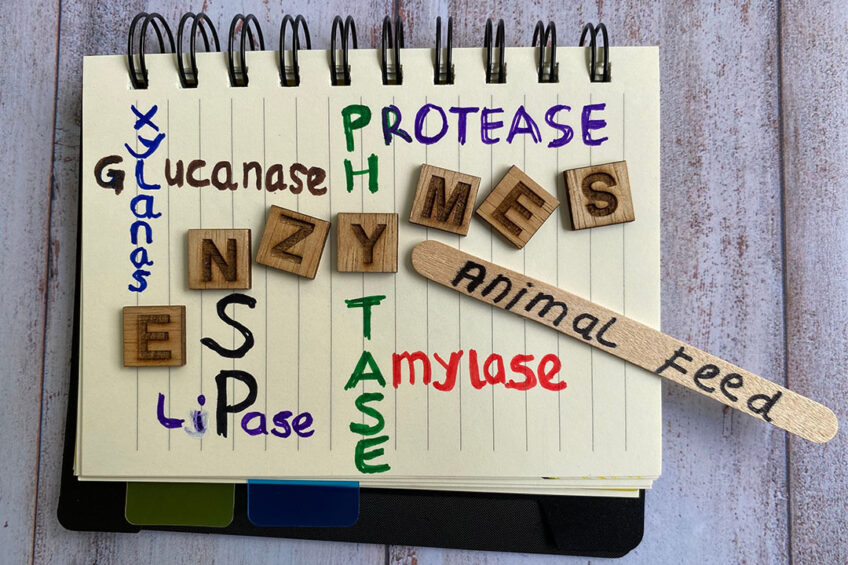Dietary supplementation of carbohydrate-active enzymes

Supplementing exogenous enzymes such as carbohydrate-active enzymes (CAZymes) in feed has various benefits including increased nutrient digestibility, reduced ammonia emissions by livestock due to enhanced nutrient assimilation, improved gut health and growth performance.
By 2050, the global population will reach 10 billion people, which will properly make feeding both humans and farm animals more challenging. This enhances the need for alternative animal feeding. Farm animals require essential amino acids due to their inability to naturally synthesise them. However, some of them have low protein digestibility because of the high content of recalcitrant dietary fibres. Therefore, there is a need to develop exogenous enzymes in cocktails or in blends to supplement different types of diets and thus improve the digestibility of feedstuffs.
Various cazymes are secreted by microorganisms such as bacteria and fungi that are naturally present in the gut microbiota. It is important to know that nutrient absorption occurs mainly in the small intestine but most of the microbiota is present in the distal compartment where nutrient absorption is poor. Thus, the enzymes action needs to occur early in the digestive tract to break down anti-nutritional factors and reduce the viscosity of the diet.
Enzymatic cocktail vs. enzymatic blends
Enzymatic cocktail is a set of enzymes created by a single organism that may or may not be genetically modified. An enzymatic blend is defined as a mixture of enzymatic products from various sources. Adding exogenous enzymes in cocktails or in blends to the feed improves the ability of monogastric animals to break down non-starch polysaccharides.
Fungal cazymes in livestock feed
Filamentous fungi have a wide enzymatic portfolio that deconstructs non-starch polysaccharides in animal feed. The fungus Talaromyces versatilis secretes a multi-enzyme cocktail including more than 50 different enzymatic activities including glucanases, xylanases, galactanases, arabinofuranosidases, polygalacturonases, xylan esterases and mannosidases which break down non-starch polysaccharides. Cazymes richness and diversity affect the set of proteins expressed by a fungus which are secreted into the extracellular space. Enzymes secreted by Aspergillus japonicus and Aspergillus terreus increase soybean meal solubilisation. The recombinant xylanase from Clostridium thermocellum is efficient in cereal-based diets.
Xylanases and glucanases are leading feed enzymes
Cereals including wheat, barley, oats, and maize are rich in cellulose, β-glucans and arabinoxylans. Glucanases and xylanases are the first cazymes identified for improving the digestibility of feedstuffs with the most widespread enzymatic activities claimed in commercial cocktails.
Supplementing xylanase and glucanase in diets containing low amounts of rapeseed meal and sunflower meal allows the recovery of body weight loss caused by the 50% reduction of protein meal inclusion. In addition, the exogenous xylanase and glucanase release nutrients to supplement a low-energy diet, rather than the breakdown of anti-nutritional compounds in protein meal-rich diets. The enzymatic cocktail of xylanases and glucanases produced by the fermentation of Trichoderma citrinoviride is effective in enhancing nutrient utilisation in wheat-soybean meal-based diets.
Impact of cazymes supplementation on health and performance
Exogenous enzymes can be supplemented in livestock diets as an alternative to antibiotics. Cazymes’ mode of action promotes the reduction of feed viscosity by hydrolysing the polysaccharides initially fermented by microbial pathogens, and enhances access to nutrients for beneficial microbiota through the production of prebiotic oligosaccharides.
Protein meals contain non-starch polysaccharides that negatively affect various gut health parameters, depending on their type and content in the diet. Non-starch polysaccharides such as pectin reduce beneficial bacteria counts into the ileum such as Lactobacillus spp. and Bifidobacterium spp., decrease the body weight gain, and increase gut lesions and mucosal inflammation. However, replacing soybean meal with fermented soybean meal in the diet degrades the polysaccharides, increases beneficial flora, and decreases pathogenic phyla.
Non-starch polysaccharides-degrading enzymes contribute to gut homeostasis and improve gut morphology parameters such as the villus length and the crypt depth.
Pectin-degrading enzymes or pectinases with hemicellulases and cellulases increase crude protein digestibility and apparent metabolisable energy in the ileum.
An enzyme mixture containing cellulases, hemicellulases, and pectinases improves body weight gain and feed conversion ratio. A commercial product containing pectinases, xylanases, glucanases, mannanases, cellulases, and galactanases improves gut physiology and growth performance.
Concluding remarks
Supplementing exogenous enzymes in feed has various benefits. However, knowledge of fibre structures and non-starch polysaccharides contents in raw materials, pH, thermostability, and the kinetics of individual enzymes are essential to develop a complex enzymatic cocktail and blend. In addition, enzyme producers need to constantly improve and adjust enzymatic cocktails and blends to address economic and ecological challenges in the livestock feed industry.
This article is based on the publication: Lauriane Plouhinec, Virginie Neugnot, Mickael Lafond, Jean-Guy Berrin, Carbohydrate-active enzymes in animal feed, Biotechnology Advances, Volume 65, 2023.











